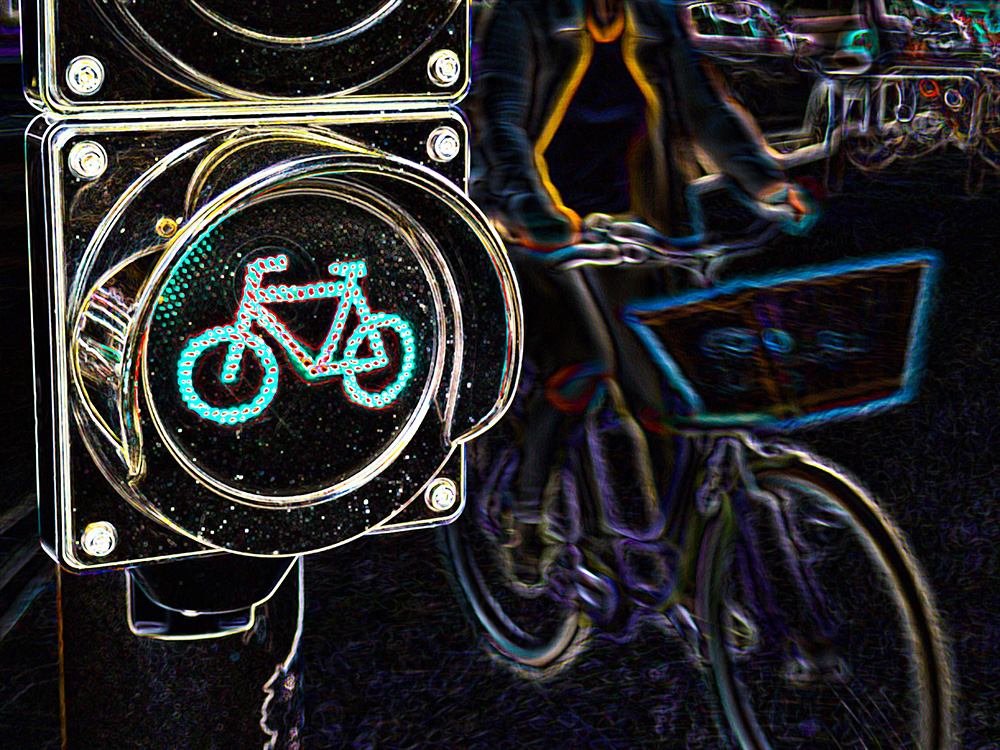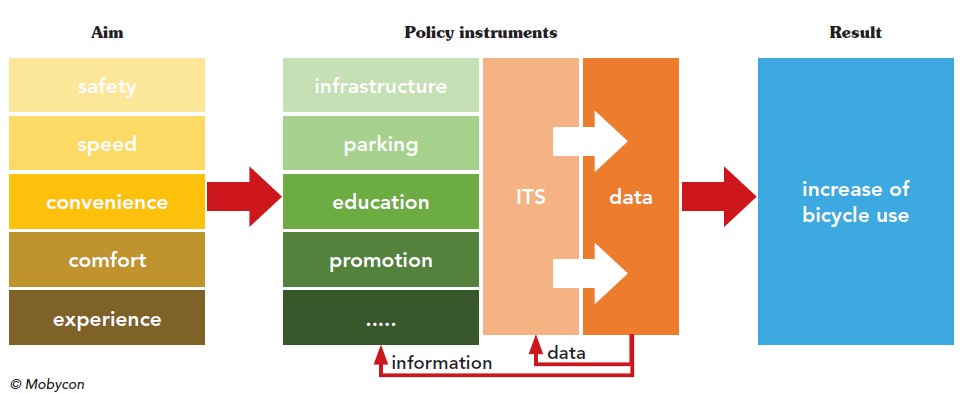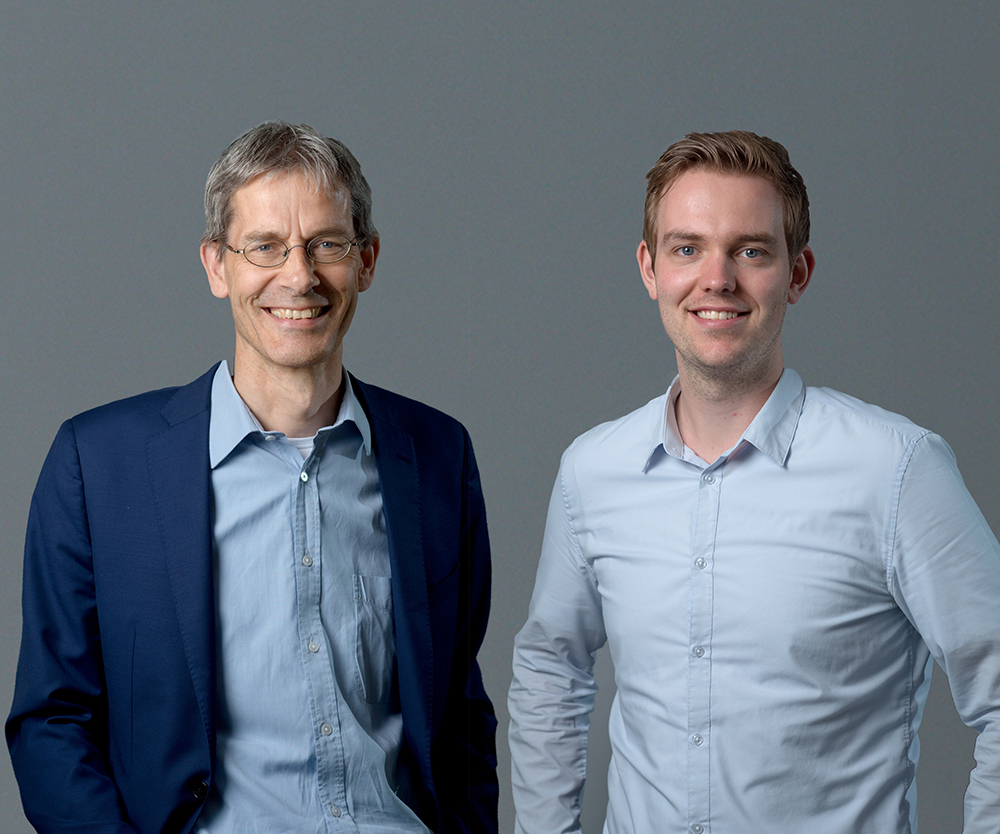
From the 1980s onwards, ITS - in those days called ‘telematics’ - has always been seen in relation to motorised vehicles: highway traffic management, smart truck parking, electronic toll collection, cooperative ITS (C-ITS) and the more future-oriented connected and automated mobility (CCAM).
However, more recently ITS has also made its entrance into the cycling domain. In fact, few weeks pass without the release of new ITS applications in cycling. In the Netherlands, and in the city of Zwolle alone, we see shared bicycles with smart locks, a bicycle parking guidance system, intelligent traffic lights giving priority to cyclists, and bicycles with devices that monitor air quality. These are just the examples of what we can actually see. Behind the scenes all kinds of cycling data are collected and analysed.
This does raise a question: will and should cycling become as 'connected' as cars or is simplicity one of the bicycle’s most valuable assets and should we keep it that way?

We believe that we should at least acknowledge the differences between cars and bicycles and the different needs and preferences of the people operating them:
- Bicycles are relatively cheap, so it is unlikely that expensive ITS equipment will be mounted to ‘ordinary’ bicycles. This might be different for expensive options like electric bikes and sports bikes, but the average cyclist will have ITS systems and services mainly through wearables, such as the smart phone.
- Bicycles are, by definition, not expected to become self-driving. If a cycle-like vehicle were to become self-driving, it would be a fundamentally different mode of transport.
- C-ITS for cycling, especially in the US, is often focused on connecting cyclists to make them more ‘visible’ for (autonomous) cars. But what happens with the cyclists that are not ‘connected’? In order to avoid car-cycle collisions, the cars and infrastructure, not the bicycle, should be made smarter.
- Where ITS for cars is mainly used for enforcement and to mitigate the negative effects of cars (safety, tolling, speed control, temporary driving bans, urban access control), ITS for cycling is mainly used to make cycling more attractive (priority at traffic lights, bike sharing, gamification). As a participant in the Oldenburg Bicycle Challenge expressed it: “I like such competitions because they motivate me to get on the bike instead of taking the car. And if there are little things to win and there are only a few kilometres to go, I'll even bike in the rain."
- In many cases cyclists are not focused on getting from A to B in the fastest possible way. Cycling is also often a social experience and a way of life. Very often the cycling experience itself is more important than speed.
- Bicycles are human-powered vehicles that depend on balance. At the same time, the bike does not have a crumple zone and impacts from crashes can be high. The crumple zone should therefore be incorporated in different ways (e.g. infrastructure, digital systems) to ensure that the impact of human mistakes (of both cyclists and other road users) is reduced to a minimum.
With these differences in mind, it is clear that ITS for motorised vehicles cannot be simply transferred to cycling and, at the same time, new, cycling-specific ITS might have a lot of potential.
What is the BITS project?
To better understand the possibilities of ITS and to effectively implement ITS for cycling, the BITS (Bicycles and Intelligent Transport Systems) project was initiated in 2019. Over the past three-and-a-half years we have assembled the necessary knowledge and experience by implementing over 30 ITS applications for cycling in five countries, including:
- Various types of bicycle parking solutions
- Data collection, including environmental data and AI near collision cameras and developing a data reflex
- A bicycle library with data-driven coaching
- Cycling apps in all shapes and sizes with different aims: nudging, reporting on cycle lane quality, getting priority at traffic lights, etc.
- How ITS can assist in Covid-proof cycling
- Priority at traffic lights and other traffic management systems
- Safety enhancement systems
- Bike sharing

In this Interreg North Sea Region-funded project we are exploring, together with cities, regions, universities, and other organisations, how ITS can make cycling safer, faster, more reliable, more comfortable and a better experience. The aim is to make cycling more attractive.
“First of all, we implement ITS that directly impact the cyclist, such as gamification apps, parking systems, and smart traffic lights,” says Marjolijn Boot, from the province of Overijssel. “Simultaneously, we invest in data applications that indirectly impact cycling. Data is being used both as input for ITS applications as well as to evaluate and improve policies. This gives us insights in the effectiveness of applications and the preconditions that apply”.
In the BITS project not only cycling ITS is demonstrated, but at the same time we have improved the accessibility of cycling data by creating the so-called CycleDataHub; an open-data portal where people can share and access cycling data. The platform is not only available for the BITS partners, but also for commercial and non-commercial external parties.
Luk Lemmens, deputy for mobility, province of Antwerp, says: “The measuring data of infrastructure, complemented with counting and crash data, come together in the provincial Bicycle Barometer. Comparing, interpreting, and analysing these figures leads to objective information and targeted recommendations that we share with the local and regional policymakers. In this way the city councils have a good basis to integrate their cycling policy in the overall mobility policy.”
Digital layer for cycling
Overall, we have found that ITS can have a large positive effect on cycling, and that ITS certainly deserves a place in the cycling toolkit. On top of the 'traditional' measures (cycle infrastructure, parking facilities, education and promotion) it is often a cost-effective solution in different circumstances (see figure below).

An additional benefit of using ITS applications in cycling is that they often generate valuable data (counts, speed, crashes), that can be used in at least two ways:
- as direct feedback to the cyclist (speed advice, nearest available bike parking, priority at traffic lights)
- to gain new insights and improve cycling policies
Cycling data is underrepresented in the overall traffic and transport data, with most data collected focused on motorised traffic. ITS for cycling offers the possibility to generate more cycling-related data. Thus, ITS can become the digital layer for cycling, and thus it will be able to give cycling data an equal status to motorised traffic data. This is also in line with EU policy, e.g. European Green Deal, the Strategy for a Sustainable and Smart Mobility, the upcoming revision of the MMTIS Delegated Regulation and also the European NAPCORE project.
Bright outlook
Looking at the future of ITS for cycling a number of developments can be expected:
- Increased interaction between the cyclist and other vehicles and between the cyclists and the infrastructure. This interaction will mainly focus on improving road safety of the cyclist and improving speed. Cyclists will be warned about dangerous situations (e.g. speed advise through C-ITS and ADAS) and traffic lights will be influenced when cyclists are approaching (e.g. through GLOSA (Green Light Optimal Speed Advice) messages).
- Increased integration of cycling in the multimodal transport chain: combining cycling with public transport, parking at public transport stations, bike sharing, MaaS. Standardisation of data will be key to success, for example GBFS, the open standard for shared mobility.
- Information provision to cyclists about routing, parking, traffic and weather conditions. This will be mainly focused on improving convenience and comfort for the cyclists. The main technology will be smartphone apps.
- Data management and usage: collection, processing, storage, interactions, standards, regulations, privacy. Data collection will move from inductive loops to radar and infrared cameras, as well as floating bike data. The data will become available through open-data platforms such as National Access Points.

Besides the developments we can expect, we may ask ourselves what kind of developments we want. Technologies will keep evolving and we can influence these developments with policies, rules, and investments. How do we want technologies to evolve further? What kind of (urban) environment do we want to live in and what does that mean for the things we should do right now? Cycling ITS has shown to efficiently bring more safety, sustainability, inclusion, health, and fun to our mobility system. As such it is a valuable tool in the cycling policy, in addition to cycling infrastructure, bicycle parking, education and promotion.
• ITS applications for cyclists, including many others from outside the BITS project, can be found in the BITS products and services directory www.bitsdirectory.com
ABOUT THE AUTHORS:
Ronald Jorna (above left) and Robin Kleine are consultants at Mobycon in the Netherlands. On behalf of the Province of Overijssel, they are project managers of the Interreg-funded Bicycles and ITS project





